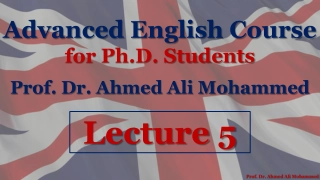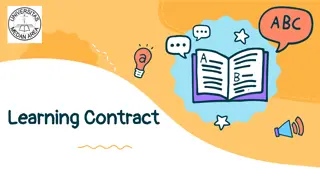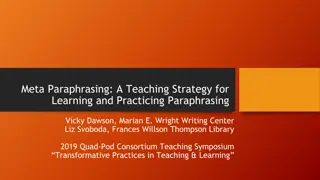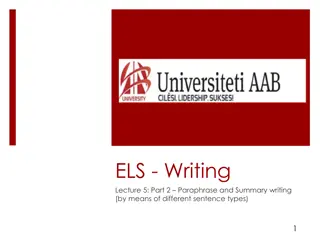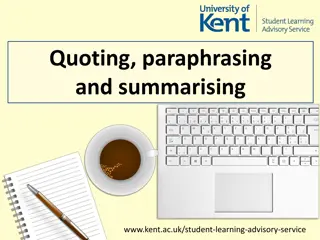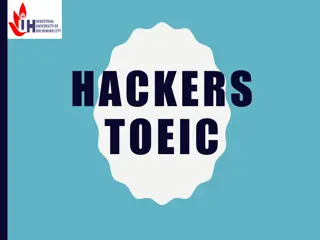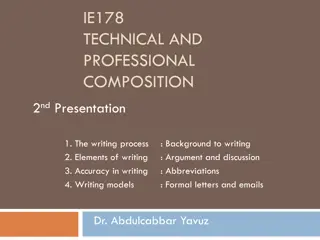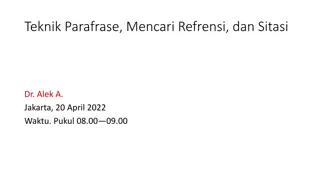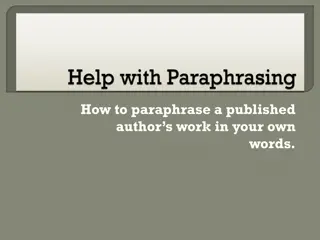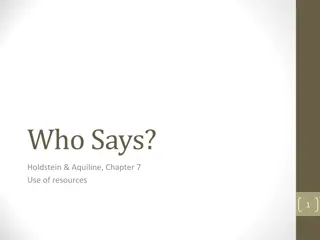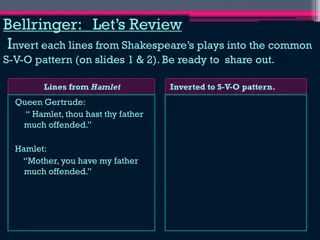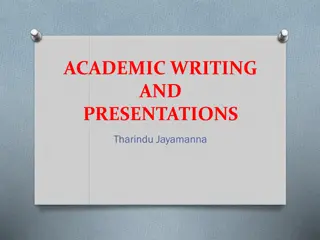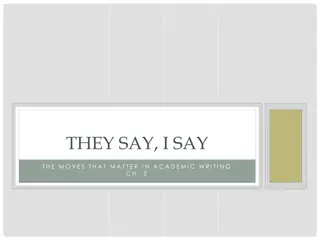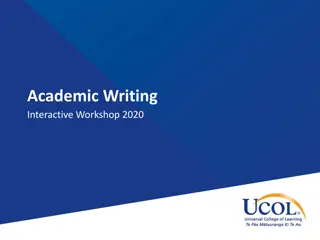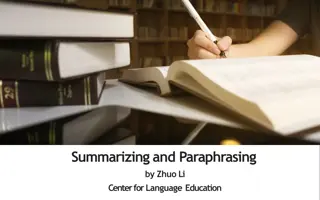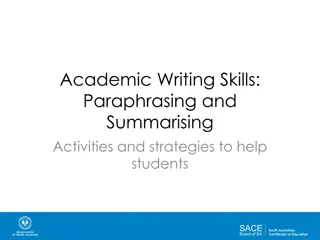Mastering Paraphrasing and Summarizing in Academic Writing
Developing the skill of paraphrasing and summarizing is crucial in academic writing as it involves interpreting complex ideas and expressing them in your own words. Proper citation is essential even when paraphrasing to acknowledge the original source. Understanding cohesive devices and identifying key information are key aspects in effectively paraphrasing and summarizing academic texts.
Download Presentation

Please find below an Image/Link to download the presentation.
The content on the website is provided AS IS for your information and personal use only. It may not be sold, licensed, or shared on other websites without obtaining consent from the author.If you encounter any issues during the download, it is possible that the publisher has removed the file from their server.
You are allowed to download the files provided on this website for personal or commercial use, subject to the condition that they are used lawfully. All files are the property of their respective owners.
The content on the website is provided AS IS for your information and personal use only. It may not be sold, licensed, or shared on other websites without obtaining consent from the author.
E N D
Presentation Transcript
+ Approaches to paraphrasing and summarising Essential Aspects of Academic Practice #3 John Morgan Student Learning Support Aberystwyth University jpm@aber.ac.uk
+Paraphrasing and summarising #1 Even if you paraphrase or summarise and write ideas in your own words, you must include a citation in your text and a reference in your bibliography. You are still basing your ideas on those you have read elsewhere. One of the main problems with paraphrasing and summarising, however, is that you are working with the published ideas of experts in the field.
+Paraphrasing and summarising As a result of this it is quite a challenge to interpret complex ideas and write them critically in your own words. In this section we will look at ways of identifying important ideas, key words that we keep the same and modes of personal expression that we must change. The focus also includes ways of determining what is relevant to your own argument and what can be left out.
+Paraphrasing: a conceptual focus on specific ideas #1 Sample text Technology and the Internet pose complex challenges for school leaders; these challenges should not be underestimated. While the Internet presents new issues to sort through and new ground to tread, it surely is here to stay. Now is the time to explore the Internet s potential for meeting the educational needs of diverse groups of students and involving their parents in student achievement. And schools that take command of the Internet as a tool to accomplish overriding goals, such as improving student achievement and galvanizing parental support, will benefit in the long run. (National School Boards Foundation, 2000)
+Paraphrasing: a conceptual focus on specific ideas #2 The text contains the following language items: Essential information or fixed information points e.g. groups of people, specific concepts Any attempt to paraphrase these could be misleading as they represent shared knowledge and common points of reference.
+Paraphrasing: a conceptual focus on specific ideas #3 Cohesive devices e.g. articles (e.g. the/an/and), conjunctions (e.g. and/but), prepositions (e.g. for, in, of) These devices are grammatically dependent and the way you write a text will determine which cohesive devices must be used
+Paraphrasing: a conceptual focus on specific ideas #4 Descriptive items, adjectives, adverbs, connectives e.g. almost all , while , well into These items are distinctively chosen as modes of expression by individual writers. There are a lot of synonyms and antonyms for these points and they should definitely be paraphrased.
+Paraphrasing: a conceptual focus on specific ideas #5 Make a list of any words or expressions you would consider to be essential information, or descriptive items (answers included in Appendix A of printed document). Consider your argument and decide which information is relevant and which can be adapted or omitted.
+ Argument A: You are writing an essay on how parents can be involved in their children s learning and how responsible use of Internet resources may assist in this. Argument B: You are writing an essay on how schools are using technology in education and how teachers need to design activities that will help with learning and engagement. Argument C: You are writing an essay on how local education authorities view the use of Internet resources in schools with a view to monitoring independent time that children are allowed to work alone or in groups.
+Possible paraphrased versions Here we are working with an isolated passage from a bigger published document and it is necessary to read what comes before and what comes after. This will help to contextualise issues. When we paraphrase, we often write texts of similar length, but we connect the ideas to our own, so we do not necessarily use all those ideas. When we do, they look sequentially very close to the original and may be criticised for being too close. Note the use of the citation in each case.
+Argument A You are writing an essay on how parents can be involved in their children s learning and how responsible use of Internet resources may assist in this. The Safe and Smart report (National School Boards Foundation, 2000) identifies some of the implications for working with the needs of children at school. Within this there is the recognition that parents should participate in their children s learning. If schools can engage with parents and identify specific learning activities and structured use of Internet access time, it will help with social aspects of learning as well as overall academic achievement.
+Argument B You are writing an essay on how schools are using technology in education and how teachers need to design activities that will help with learning and engagement. The Safe and Smart report (National School Boards Foundation, 2000) identifies a number of crucial concerns for the use of the Internet in education. As a new medium in the development of educational resources and methods, the Internet is a valuable means through which the needs of a wide range of students can be addressed. In addition, it suggests that parents can be increasingly involved in their children s learning, fostering greater student achievement. Teachers that recognise and participate in the development of such ideas, despite facing some difficulties at the beginning, will contribute positively to increased educational standards on the whole.
+Argument C You are writing an essay on how local education authorities view the use of Internet resources in schools with a view to monitoring independent time that children are allowed to work alone or in groups. The Safe and Smart report (National School Boards Foundation, 2000) identifies issues that are important to the development of informed policies that will help schools to use the Internet in classrooms effectively. While it is recognised that schools must embrace technologies, there are a number of concerns about children s security online that must be addressed before it is possible to allow independent learning time in classrooms. It is necessary to discuss these ideas with parents so they can monitor children s time on the Internet in homework activities. This will help with setting achievable targets for educational achievement.
+Sequential ideas Sequentially the ideas in these paraphrased are relatively close to the original, especially in Argument B, where the focus of the essay is similar to the original text. They have connected these ideas, however, to wider concerns that are not directly mentioned in the original. These are part of the emerging perspectives of three related, but different, perspectives. What the reader can see here is the development of ideas that connect to your own argument, rather than a sequence of ideas that look quite like the original, but do not actually add or interpret those ideas.
+Summarising: a situational focus on overall ideas #1 One of the most important aspects of summarising and paraphrasing is knowing how much of the original work it is advisable to include. If too much is included it will be criticised for relying too much on other sources and it will also be a form of unacceptable practice. If too little is included the work will be criticised for not reviewing reference sources and it will not gain high marks.
+Summarising: a situational focus on overall ideas #2 Read the text sample on summarising, paraphrasing and synthesising from Jordan (1997: 170-171). Make a list of all the citations in the text (note the balance of integral and non-integral citations) How would you describe the cited ideas? Paraphrase of a specific idea Summary of an overall idea Acknowledgement of useful or similar source Brief indication of an idea without summary or paraphrase Example Other
+Summarising: a situational focus on overall ideas #3 After reading this, how much of the text that you see is based on the work of others? Which statements does Jordan use to connect the ideas to his own perspectives? As seen in the Jordan s text, Johns (1988) recommended a focus on situation, problem, solution and evaluation as a way of approaching summarising. When summarising, it is not necessary to include all ideas are you are trying to reduce the length of the original while using a selection of key points that are important to your work.
+Summarising: a situational focus on overall ideas #4: Situation Sentences or ideas related to situation: The ability to summarise is integral to good writing (Jordan, 1997). Most summaries are a result of note taking from reading (Jordan, 1997). Use of problem/solution text (quoting Jordan s deliberate positioning of the two ideas).
+Summarising: a situational focus on overall ideas #5: Problem Sentences or ideas related to problem: Processes are not clear and often not taught (Jordan, citing Johns, 1988). Follows the assumption that students will be able to actually do things just because they are told to (leave out, or choose different example) (Jordan, citing Johns, 1988). Specific procedure recommended of identifying four categories important to the critical discussion of any point: situation, problem, solution, evaluation (summarising Johns, 1988)
+Summarising: a situational focus on overall ideas #6: Solution Sentences or ideas related to solution: Approach to identifying main structure of text. Students write summaries based on the notes from each stage, which has now separated them to some extent from the original sequence.
+Summarising: a situational focus on overall ideas #7: Evaluation Sentences or ideas related to evaluation: Higher levels of accuracy and understanding of original text (Jordan, quoting Johns, 1988, but paraphrased here) Note that this evaluation appears early in the text. As the writer continues, he brings in citation and review of others sources, but has effectively finished with his review of Johns in this section.
+Two summarised/paraphrased texts based on Jordan (1997) Which ideas would you say are summarised, which are paraphrased and which are a blending of both? Which ideas are not mentioned in Jordan s text? These latter points are the connection with the wider idea that should be related to the main issue and aims of an essay.
+Summary and paraphrase Jordan (1997: 170) has argued that the ability to summarise is integral to good writing. He bases this claim on the work of Johns (1988), whose use of a problem/solution text approach helps students to work with methods of note taking that will help facilitate the ability to write more freely in their own words. The processes of summarising and paraphrasing are not always clear and the simple instruction that students should write in their own words does not provide adequate preparation for critical writing. Through Johns use of identifying sentences or passage that relate to the situation, problem, solution and evaluation of a given text, it is possible for students to identify the main structure of the text. The summaries that are written on this basis are now separated from the main sequence of the text and are more likely to be written in the students own words. Overall this leads to higher levels of accuracy an understanding of the original text and a better integration of reviewed ideas within student essays.
+Paraphrase and summary Jordan (1997: 170) identifies a close connection between the work of Johns (1988) and Edge (1983). Edge focuses closely on the essential value of writing summaries through a pair- work approach to note taking. Students work together over each stage of the review. The more challenging aspects of the review can be identified and given further attention as they proceed. On completion of this stage students work together to co-write a summarised version of the original.
+References included The bibliography for the citations included in the summary and paraphrase above must include all cited sources. Those identified through Jordan s book should be acknowledged that way. At this stage you may not have done further reading of the original texts by Edge and Johns. If you do read the originals and make further direct reference, it is still good to note that they were also cited in Jordan, as it will extend the depth and scope of your overall review.
+Single source and chain of references Edge, J. (1983) Reading to Take Notes and to Summarise: A Classroom Procedure. Reading in a Foreign Language 1/2. In Jordan, R.R. (1997). Johns, A.M. (1988) Reading for Summarising: An Approach to Text Orientation and Processing. Reading in a Foreign Language 4/2. In Jordan, R.R. (1997). Jordan, R.R. (1997) English for Academic Purposes: A Guide and Resource Book for Teachers. Cambridge: Cambridge University Press.
+Next Essential Aspects of Academic Practice #4 Writing a bibliography and associated style guide features


